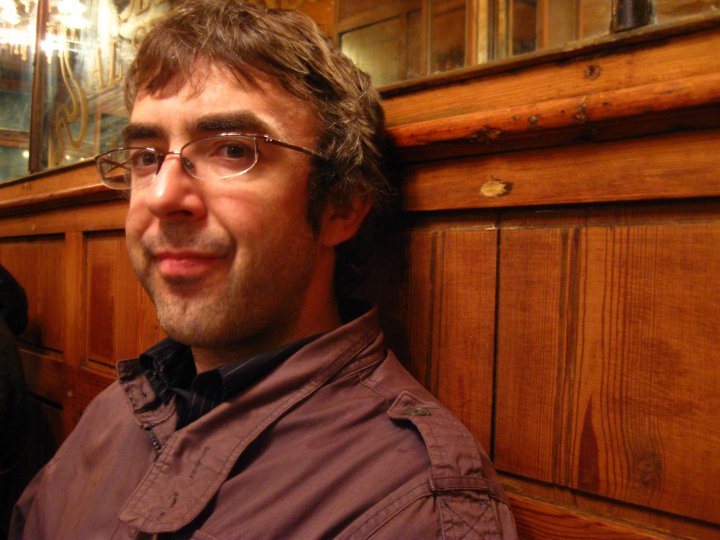My brother St Ronan gave me
the first fulmar of spring, but when
he praised my legs as I prayed
something screamed louder
than a storm beach of seals,
touched closer than the snugness
of a bed among rocks. I would not
have it: set sail, becoming
the flat earth’s edge, living on guga
and cress, telling my prayers
by the light of a cormorant lamp,
its pentecostal tongue
its own wick. In its oily glare
nothing is illuminated.
Shall I preach to the birds?
I have seen the fork-tailed petrels
walk on water. It is no wonder
the miracle would be to see them
walk on land: a dozen yards
from shore they are wrecks,
lost for want of the ground
giving way. What, if I preach
to the birds, should I promise them
more than they have? The petrels
nest on the waves, an egg
under each wing. Fall
and ascend. I go down
easy into the earth, rise
again to the wispy tuft
of a shag’s nest under
my picked-clean ribs.
* * *
According to legend, St Ronan of Iona was tormented by devils. This suggests he wrestled with sins of the flesh. Perhaps it was a wise decision on his sister’s part, when, after he’d told her she had beautiful legs, she replied, “It’s time to leave” and set off promptly for the island of Sula Sgeir.
A Nest on the Waves
by David Wheatley
Buy it from the Guardian bookshop
Search the Guardian bookshop
In this week’s poem, “St Brenhilda on Sula Sgeir”, from David Wheatley’s new collection, A Nest on the Waves, recently published by Gallery Press, Ronan’s sister describes her own ascetic life, death and strange resurrection. Unlike St Francis of Assisi, also the subject of a poem in the collection, Brenhilda claims no deep kinship with the birds that keep her company. The voice given her is brisk and cold. Already she seems subsumed into the landscape, summoning her sense of violation through harsh local analogies: “something screamed louder / than a storm beach of seals, / touched closer than the snugness // of a bed among rocks”. Although she begins by mentioning Ronan’s gift of “the first fulmar of spring”, I don’t imagine this to have been a fluffy pet chick, but a valued delicacy. Guiltlessly, she devours the young gannets (guga), and uses a cormorant as a lamp.
I was reminded of the Siberian evenki, who depend on their reindeer for food, shelter, transport, clothing, yet revere the creatures they utilise. After a little research, I found a book called Good to Eat, Good to Live With: Nomads and Animals in Northern Eurasia and Africa. Perhaps Brenhilda’s attitude to the wild fowl is not dissimilar.
The image of the cormorant with the flame of a “pentecostal tongue” emerging from its beak is disturbing: we remember the cruciform shape of the bird as it spreads its wings to dry, pointed out in another poem, “Flotsam”, which begins: “A cormorant drying its wings / steps down refreshed from its cross.” But protein and light are necessary, even for an ascetic. There is no apology, and the tone maintains its realism. This saint decides there is no point in preaching to the birds.
Although she believes the myth about the fork-tailed petrels, Brenhilda watches them with a naturalist’s eye. They appear to walk on the water, but this doesn’t make them Christ-like. As she observes, “the miracle would be to see them // walk on land”. Ill-adapted to terra firma, they are “wrecks” when stumbling along the shore.
Somehow, the triplet stanzas also have the rhythm of the waves in them. The sentence often flows on over stanza break, and finds its caesurae in designedly awkward places. There is a stress on the negative: “I would not / have it”; “In its oily glare / nothing is illuminated.” A frequent little underswell of dactyls. (“telling my prayers”) and anapaests (“they are wrecks”) adds to the choppiness.
What are Brenhilda’s claims to sainthood? The poem doesn’t tell us. She repeats the story that the petrel nests on the waves, keeping an egg under each wing, in a tone that might be envious. Perhaps she is reminded of her sacrifice. There is no suggestion that she has been spiritually recompensed. She might almost be a kind of female Buile Suibhne, the king who was punished by another St Ronan and became half-man, half-bird. In fact, there’s a version of Brenhilda’s legend in which her exile is a punishment for some sin of her own.
Towards the end of the poem the rhythms become quieter. The tension relaxes with that simple, melodiously positioned phrase “Fall / and ascend.” Now Brenhilda seems to feel something like pleasure, and to absorb the rhythms of the sea-birds.
In her final metamorphosis, she merges with the landscape. The poem follows the legend that, after her death, she was found in a bothy, with the nest of a shag tucked in her ribcage. So she, in turn, has entered the food chain to provide nourishment (“my picked-clean ribs”) and shelter for the wildlife. Standing on its own, the last line declares the final barrenness, and saint-like perfection, of her extinction. There are no human inhabitants on Sula Sgeir today, and though the annual guga hunt continues, the gannet colonies seem to be flourishing.



No Comments